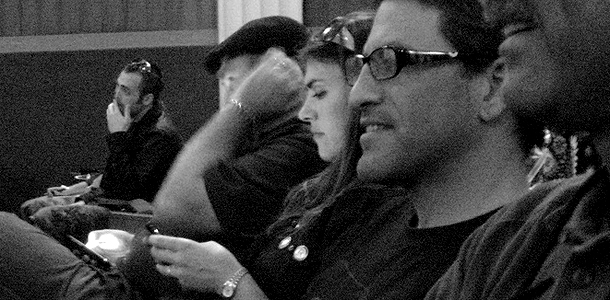Giving A Kick-Ass Presentation In The Age Of Social Media
Seven (somewhat snarky) new rules for public speaking in the social media era.

It was painful to watch. Jon Bond, the former ad giant turned social media honcho, was actually getting heckled at the Pivot Conference. When faced with what was a feisty crowd to begin with, Bond admitting that he "didn't like Twitter" was like throwing fresh meat at rabid dogs. But rather than raise their voices, they let their fingers do the shouting. So while Bond continued to speak, a steady stream of snarky tweets projected on the wall behind him, acting like foghorns and essentially drowning him out.
Being a great speaker was never easy, but now, with your audience likely to have a mobile device in hand and real-time access to multiple social channels, the challenges have gotten that much greater. To get a sense of the impact of social media on conference presentations, I interviewed a bunch of regulars on the social media circuit. In the process, they helped me identify these seven (somewhat snarky) new rules for public speaking in the social media era.
1. Don't Panic if They Aren't Looking at YouSure, it's disconcerting when you gaze out at the audience and no one looks back. But whatever you do--don't panic. Just because they are transfixed by their mobile devices, doesn't mean they aren't all ears. "I think the body language tells you if they're paying attention--it's far more distracting to see people whispering to each other than it is to see someone tapping on an iPad" said Jenny Dervin, VP of Corporate Communications at JetBlue, who received raves at a recent BDI event.
2. Stifle the Temptation to Ask for a Device MoratoriumAs tempting as it might be to ask your audience to shut down their devices, every speaker I talked to thought this would be a huge mistake. "I might get their undivided attention, but it would be mixed with their ire at being told how to watch my presentation," said former actor and speaker extraordinaire John C. Havens, who reminded me that in the old days, before digital devices, a lot of people would take notes on a pad of paper, which isn't all that different than tapping out a tweet.
3. If You Aren't Nervous, You Should Be NowWhen I first learned public speaking, an experience advisor suggested that you "imagine the audience is naked," to quell the initial butterflies. Today, speakers are probably better off reminding themselves that they are the naked ones. If your facts are wrong, your audiences will Google then tweet the corrected data before you can say, "I'm just sayin'." And if that isn't scary enough, as author and speaker Jeff Jarvis proclaimed this year at TED, "the lecture, as a form, is bullshit," so you better ask yourself what you're doing up there, anyway!
4. If You Don't Speak Twitterese, It's Time to Learn ItLet's just imagine for the moment that your audience is absolutely riveted by your every word. Chances are some, if not many of them, will want to share your wisdom with their network, not tomorrow when they get back to the office, but right at that very moment. It is for this reason today's effective speakers are not just sharing their Twitter handles upfront but also mixing in tweetable quotes. "Puns, sound bites and pithy phrases are [also] ways to aid in retention," Havens said.
5. Congratulations! You May Be Speaking to Millions You Can't SeeThe irony of speaking in the social media era is that audience in front of you may be far less significant than the collective reach of that particular group. "I'd much rather have the broader reach; it is one of the better measurements of speaking at events," said Frank Eliason, SVP of Social Media for Citibank. Havens adds that if his audience is glued to their devices, "odds are half of them are tweeting about my presentation and they're helping market me!"
6. The Reviews Are In--In Real TimeRather than waiting to ask a friend after the fact how you did, today's skilled presenters welcome this feedback in real time. "It's fun to respond to a tweet when I am on stage, and it personalizes the interaction with the audience," said Eliason. JetBlue's Dervin finds these tweets helpful as well. "I go back in the stream to see what landed, based on how many people tweeted the same quoted," he said. "It's an instant evaluation of my key messages."
7. When All Else Fails, Surprise the Audience with HonestyBringing this article back full circle, Jon Bond perplexed the Pivot crowd with his admission of not liking Twitter. While this honesty may have cost him some street cred with a Twitter-loving crowd, I recently saw another speaker use honesty to extraordinary advantage. Ray Kerins, VP of Corporate Communications at Pfizer, transfixed a BDI crowd with tales of a crisis that had befallen ChapStick on Facebook the day before. By admitting that Pfizer's social media activities were a "work in progress," Kerins earned credibility that reverberated through the Twitterverse.
Final Note
All of the people we spoke to for this piece are very effective speakers, and though each has their own distinctive style, there are a few other commonalities I'd like to point out. First, none of them depend on word-laden PowerPoint presentations. Second, most are good storytellers and use humor, often self-deprecating, to connect with their audiences. Finally, each of them manages to keep their presentations short enough to allow time for a healthy Q&A. Speaking of Q&A's, you can find my complete interviews with Dervin, Havens, Eliason, and Jarvis on TheDrewBlog.com.
For more leadership coverage, follow us on Twitter and LinkedIn.
[Image: Flickr user ubrayj02]
Original Page: http://www.fastcompany.com/1792478/giving-a-kick-ass-presentation-in-the-age-of-social-media?partner=rss
Inviato da iPad
Nessun commento:
Posta un commento